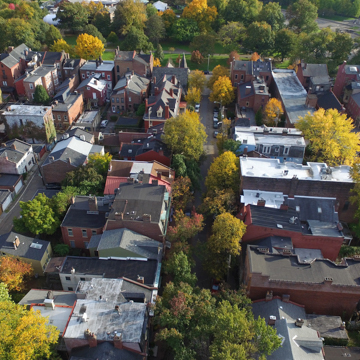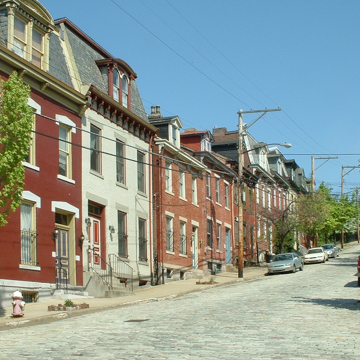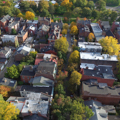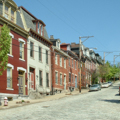This core district of the North Side constitutes the largest area of development in uniform architectural style in the city and, with its brick herringbone sidewalks and new trees, it is one of the most pleasing neighborhoods visually. The North Side's oldest institutional building, an orphan asylum later purchased by the Allegheny Ladies' Relief Society to house Civil War widows and renamed the Allegheny Widow's Home preceded the residential buildings. Today known as the Renaissance Apartments, offering subsidized housing for the elderly (1838, John Chislett; 1873 additions; 1984; 2006 renovated, Landmark Design Associates; 1308 and 310–322 N. Taylor Avenue), the main brick building of the complex was
Robinson, the first mayor (in 1840) of Allegheny City, around 1850, subdivided a portion of his inherited land just north of Allegheny Commons Park into approximately three hundred lots on twelve city blocks. Having just returned from military service in the Mexican War, Robinson named the streets after battles and generals of that conflict: Monterey, Palo Alto, Sherman, Taylor, and Resaca. Building followed, beginning in the 1850s with Greek Revival (mixed with some Italianate detailing) houses around Arch Street at the east, and ending in the 1870s in Richardsonian Romanesque around Brighton Road at the west. Unlike contemporary developments in Philadelphia or Baltimore, these houses went up independently, not in rows. They are of similar size (generally twenty feet wide and two stories high) and material (nearly always brick, though with a few standouts in wood frame or brownstone). There are some rare breaks between the homes.
By the early twentieth century, middle- and upper-class residents had abandoned these houses to renters and boarders. By the 1950s, the buildings had fallen into disrepair and the neighborhood was unsafe. Very few homes were torn down, however, as there was simply no economic incentive to do so. In the 1970s, these streets became one of Pittsburgh's earliest ventures into the historic preservation of a complete neighborhood, spurred by the new Pittsburgh History and Landmarks Foundation (PHLF). Today one of the premier preservation groups in the nation, the PHLF bought homes for resale either restored or as is, and also assisted landlords in maintaining their rental units. The result was, for the most part, an avoidance of the phenomenon of gentrification. The Mexican War Streets today have a growing and heterogeneous population, all concerned with preserving this gem of a neighborhood.





